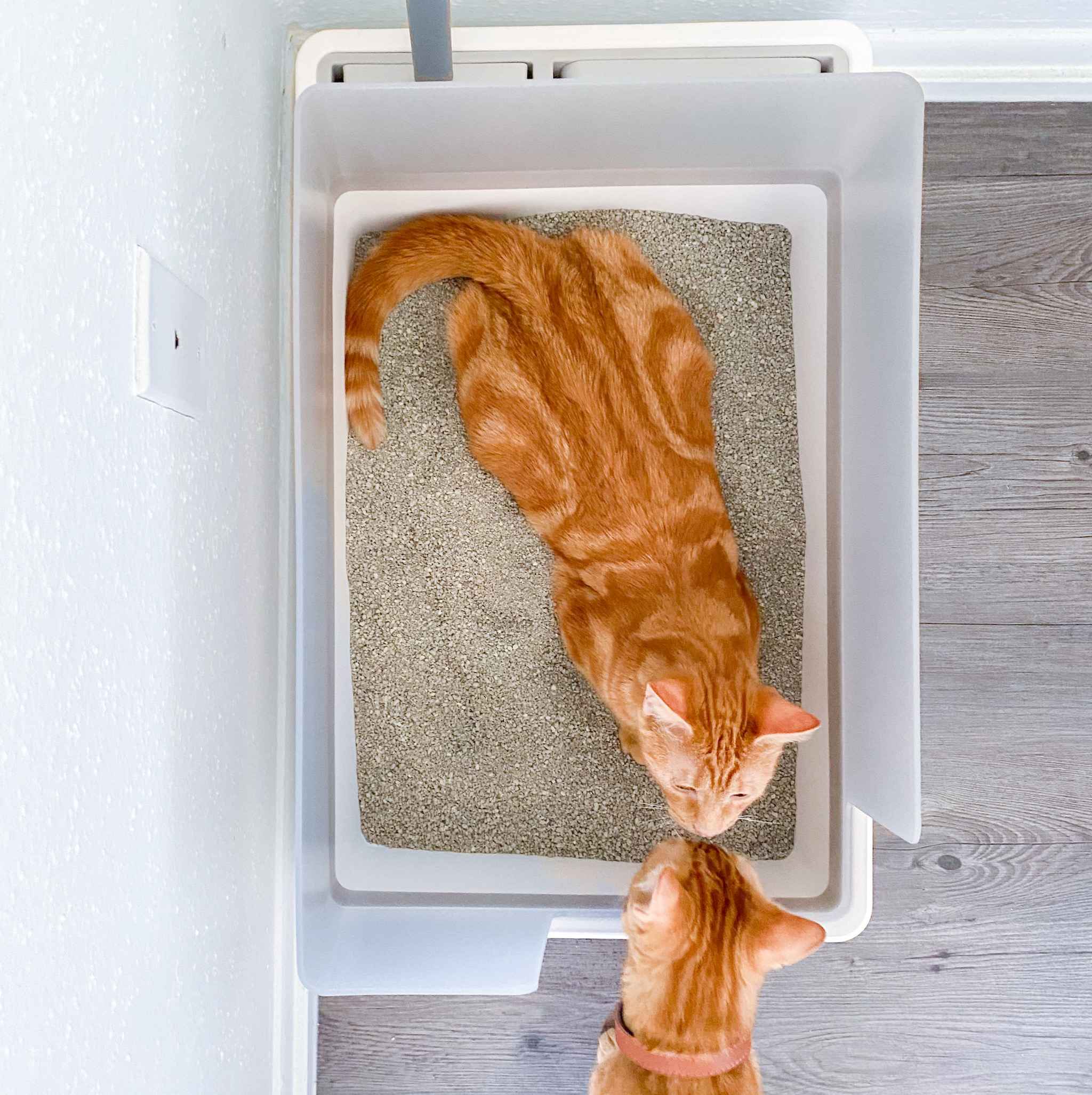It can be difficult to tell when your cat is in pain – after all, cats can't tell us what's wrong. But there are certain signs that you should look out for that could indicate your cat is uncomfortable or in distress. With practice, you can become your cat's preliminary diagnostic pain test and catch potential health problems before they become serious.
In the wild, small cats are in the middle of the food chain—they prey on smaller animals and they are preyed upon by larger predators. Hiding pain is a necessary survival tactic against predators that target visibly weakened animals. Unfortunately for cat parents, that successful evolutionary tactic makes our lives harder when we're trying to decode the signs of our cat's discomfort.
Here at tuft + paw, we are cat experts. To write this article, we consulted veterinarian Dr. Megan Teiber and gathered information from vet-reviewed resources and respected health authorities like the AAHA (American Animal Hospital Association).
Signs of Cat Pain
The main principle to follow when you suspect your cat is in pain is to look for any noticeable changes in your cat. We're talking behavior, vocalizations, eating habits, activity levels, grooming, socializing, almost anything. If they suddenly start doing something new, or they stop doing something that they usually do, that's your cue to keep an eye on them. See our definitive guide to cat behavior for more tips on interpreting vocalizations and body language.
The second principle to keep in mind is that cats are more likely to show signs of acute pain than chronic pain. Acute pain from injuries or illness will often be accompanied by obvious physical signs like limping or excessive meowing. Chronic pain manifests in gradual behavioral changes over time. For example, an aging cat with arthritis may become less active or grumpier.
If you want to see an example of clinical tool that vets use to assess cat pain, you can check out the Glasgow Composite Measure Pain Scale (CMPS) — Feline. Pain relief medication is recommended for any cat who scores 5/20 or higher. Below are the main signs to look for from a cat in pain.

Unusual Vocalizations
A cat in pain may start making abnormal noises. Common vocalizations include excessive meowing, crying or yowling, and growling or hissing when approached. Another common sign for cats with gentle temperaments is purring in odd situations.
Body Language
Changed body language is a fairly reliable sign of discomfort in cats. They often assume a tight ball-like shape with a hunched/arched back, head low (at or below shoulder level), and their front legs tucked under their chest. It looks different and more tense than the usual "loaf" position. This is a common way to distribute their weight forward and alleviate pressure from sore rear legs or hips. If cats have painful joints, they may also stop stretching out when lying down, instead keeping their legs underneath them.
Facial Expressions
Decoding pained facial expressions in your cat can take some practice, but here are a few signs to look for. For practice, you can consult the University of Montreal's Feline Grimace Scale. Pain relief medication is recommended for any cat who scores 4/10 or higher.
- Ears — flattened or spread to the side.
- Eyes — squinting/closed or a vacant stare with dilated pupils. This can give them a wide-eyed look. Cats with conjunctivitis may have a visible nictitating membrane, the third eyelid that originates from the inner corner of the eye. Below is a diagram from the Feline Grimace Scale showing how cats may squint as their pain increases.
- Mouth — tense or compressed. A tense muzzle will appear more elliptical or flattened than a relaxed round muzzle.
- Whiskers — straight and angled away from the face. Relaxed whiskers will curve downwards slightly and be held close to the face.

Credit: University of Montreal
Hiding
A cat in pain will often seek a safe hiding place in the house, much as their wild counterparts would. They may withdraw from social situations and avoid loved ones, spend lots of time in reclusive spots (e.g. under the bed), and not want to be handled or pet as usual.
Aggression
If you have a friendly cat who suddenly behaves aggressively when approached or handled, then something is definitely making them act that way. They are likely in pain and do not want to be touched.
Changes in Activity or Mobility
When a cat is in pain, their usual activities are disrupted. They may sleep more or less than usual because they're ill or having trouble getting comfortable. You may find them sleeping in weird locations, especially warm or low-lying areas. When awake, they may be restless and have lots of nervous energy, but not be interested in playing. Conversely, if they are having musculoskeletal pain, they may be less active and avoid running, climbing, jumping, scratching, standing up, or using stairs. If they are limping or walking gingerly, this is an obvious sign of pain in that limb.
Change in Litter Box Habits
Using the litter box requires a certain level of mobility, so elderly or arthritic cats may eliminate elsewhere because they're having trouble entering the litter box. Cats with urinary or digestive problems may also avoid the litter box because they associate it with pain. Straining or vocalizing while eliminating is another surefire sign of discomfort.
Abnormal Grooming
Healthy cats are meticulous self-groomers, so changes in grooming habits can be a sign of other problems. A cat may excessively groom an irritated spot, sometimes to the point of hair loss or bleeding. If you repeatedly see them fixating on one spot while grooming, it's worth getting checked out. On the other hand, a cat with mobility issues may stop grooming themselves if it becomes too painful. If you notice your cat's coat looking greasy, dirty, dull, dandruffy, or generally unkempt, that's another sign to go to the vet.
Panting
Unlike dogs, panting is not normal behavior in cats. Rapid breathing can be a result of overheating or stress caused by acute pain.
Change in Eating Habits
Cats in pain sometimes display changes in their appetite and thirst levels. If you notice your cat is eating or drinking less than usual or is losing weight, you should see the vet. Not eating for 3-4 days can cause fatty liver syndrome in cats and lead to serious health problems or death. If your cat has difficulty chewing or makes weird facial expressions while eating, that could indicate dental pain.

Dock Bowl and Stand by tuft + paw - Shop Here
How to Help Your Cat in Pain
Accommodate Your Cat at Home
There are many small changes that can make your home more comfortable for your cat. These methods can help treat a specific problem (e.g. an arthritic cat avoiding a high-sided litter box), but are also generally helpful for any uncomfortable feline.

- Keep quiet — reducing stress is key when you have a cat in pain. Move quietly, avoid playing loud music, and generally keep the house as tranquil as possible.
- Provide comfy resting spots — Add padding to their favorite hangout zones, make blanket nests on the couch, or put cushions on the ground. Make sure they have a comfortable rest stop in every room.
- Ensure food and water is accessible — If you live in a multi-floor home, put a food bowl and water source on every floor. If your cat has been keeping to one area of the house, move their food and water nearby.
- Get a low-sided litter box — Cats with joint pain often have trouble stepping into litter boxes and squatting to do their business. Make that process as easy as possible for them by providing a low-sided litter box that requires minimal mobility to access.
- Add ramps or stairs — If your cat is reluctant to jump, provide pathways that they can walk on to access their favorite spots.
- Cover smooth floors — Add rugs or mats to smooth floors to aid your cat's stability and reduce their chance of slipping.
Observe Your Cat
Observe your cat closely and take notes if you suspect they're in pain. Keep track of details like whether they have a limp, if they’re overgrooming one part of their body, or they avoid certain things. This kind of information is very helpful for the vet because they don't know your cat's personality and habits like you do. Plus, cats don't always behave normally in the stressful environment of the vet clinic. If you feel up to the task, you can even check their breathing rate or heart rate.
NEVER Give Your Cat Human Medication
Dr. Teiber stresses that cat parents should NEVER give their cats human supplements or medications. Cats metabolize drugs differently than humans (and dogs), so only administer medication that's been prescribed by the vet. For example, ibuprofen is a common human painkiller, but is highly toxic to cats.
How the Vet Can Help Your Cat
If you think your cat is in pain, a visit to the vet is always a good idea. Dr. Teiber says that "vets can help by performing a good physical exam and diagnostics to discover and treat the underlying cause of the pain. For cats showing subtle or nonspecific symptoms (such as a decreased appetite or general grumpiness), this will likely require casting a wide net with a comprehensive blood panel, urinalysis, and full body x-rays. Vets may be able to treat the pain by treating the underlying disease, or they can prescribe analgesic medications ."
Dr. Teiber recommends an immediate visit to the vet if your cat is:
- unable to walk
- breathing heavily
- suddenly howling in pain
- unable to urinate
Other signs of pain are not necessarily a true emergency, but she still recommends a vet visit within a couple days if possible.

What Causes Cat Pain?
Here are some common causes of pain in cats according to Dr. Teiber. Your vet will be able to determine the exact cause and can treat your beloved feline accordingly.
- Arthritis or musculoskeletal injuries — arthritis is one of the most common causes of chronic pain, especially among elderly cats. Highly active cats can sometimes injure themselves while playing, running, or jumping.
- Dental disease — cats can suffer from gingivitis, tooth decay, exposed nerves, and other dental issues that severely affect their eating habits.
- Urinary issues — this includes bladder inflammation and bladder/kidney stones.
- Gastrointestinal issues or constipation — cats can suffer from conditions like inflammatory bowel disease (IBD) and colitis, or simple blockages from eating foreign objects.
- Itchy or inflamed skin or ears — itchiness in cats is known as "pruritus" and is most commonly caused by infections or allergies.
Conclusion
There is no quick fix or easy explanation for cat pain, and it often requires some detective work to figure out the cause. We recommend seeing the vet as soon as you think something is wrong with your cat. Thankfully, many cases will resolve on their own with a little rest and relaxation, but it's always better to be safe than sorry. We hope this article has been helpful for you, and we especially hope that your cat has a speedy recovery from whatever is ailing them.
If you're looking for more educational cat content, check out some of our other blog articles below:
Suggested Reading
What to Do If There's Blood In Your Cat's Stool
Toxoplasmosis in Cats: Everything You Need to Know








